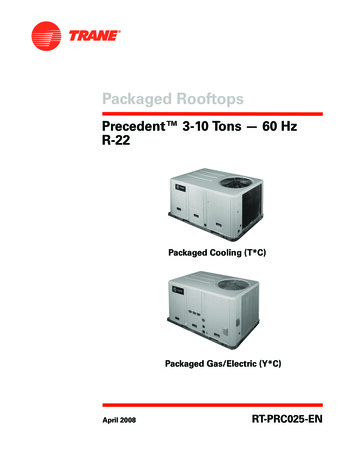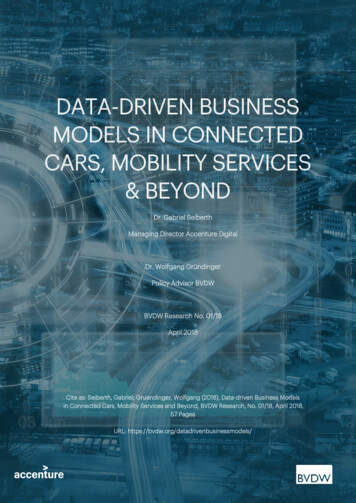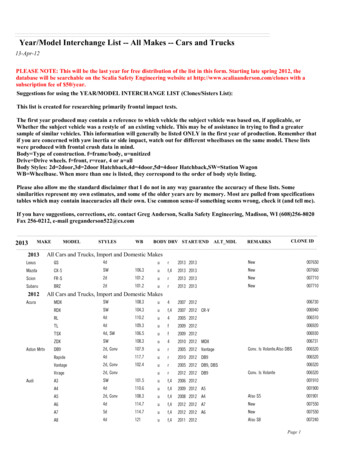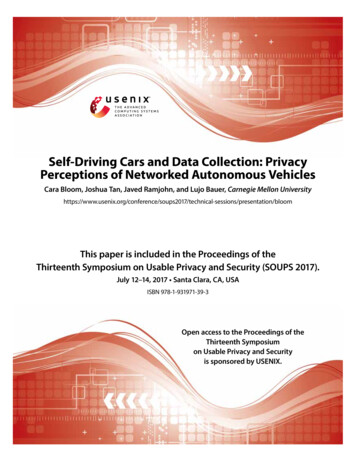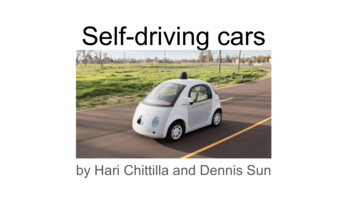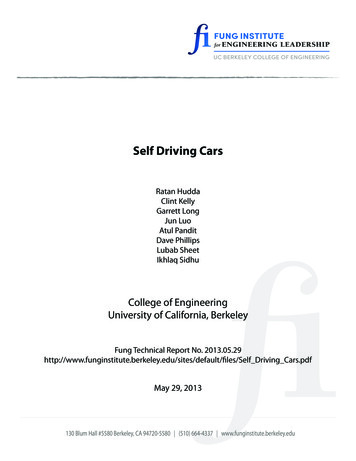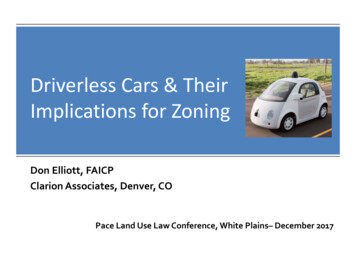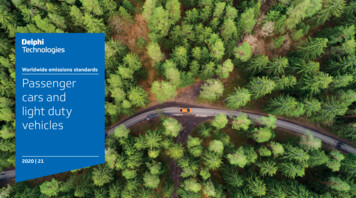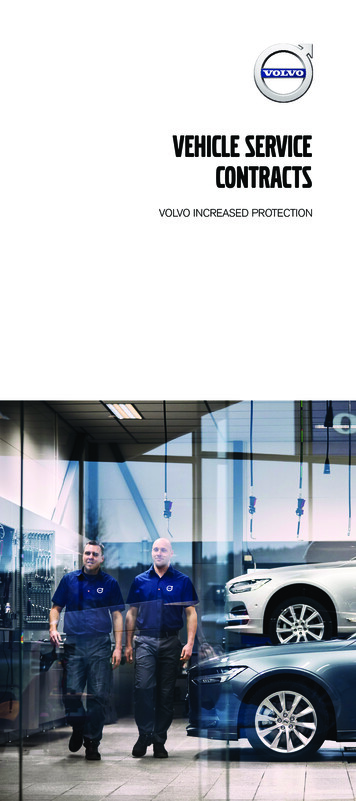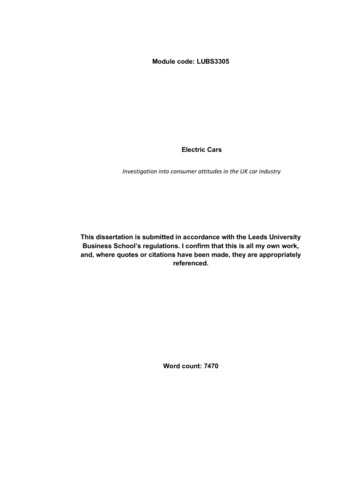
Transcription
Module code: LUBS3305Electric CarsInvestigation into consumer attitudes in the UK car industryThis dissertation is submitted in accordance with the Leeds UniversityBusiness School’s regulations. I confirm that this is all my own work,and, where quotes or citations have been made, they are appropriatelyreferenced.Word count: 7470
AbstractSince the early 1900s global car ownership has continued to climb ataccelerating rates. However, concerns about environmental and depleting fossil fuelsare forcing manufacturers to look at alternatives to the combustion engine.This thesis looks at the attitudes and perceptions of consumers in the UnitedKingdom of electric cars and aims to understand how the industry can manage andencourage this change.As a new technology, this thesis believes that it is appropriate to return to ageneralised view of consumers, rather than a focused view of consumers by thecurrent auto industry.Following a review of literature in the field and an in-depth survey aimed atthose who are likely to take an active interest in the topic, extensive analyses isproduced, identifying a number of significant findings that may hinder or encouragethe growth of electric vehicles in the UK.2
AcknowledgmentsThe researcher would like to pass on their most sincere thanks to John March(BSc, MBA) of Leeds University Business School whose support and guidance wasinvaluable to the production of this paper.3
ContentsIntroduction5Literature Review9Methodology17Findings19Analyses and Discussion22Conclusion34References35Appendices464
IntroductionFollowing the launch of the Model T Ford in 1908 (Alizon et al, 2009) carownership spiralled with over 1.5 billion cars in ownership globally today (GHO,2015). Despite over 100 years now passing, cars are still driven by the same principletechnology; the combustion engine (Bergthorson and Thomson, 2015). Thecombustion engine provides a huge array of benefits, from car performance in termsof speed and range to the ability to simultaneously charge the vehicle’s battery inorder to power an array of electronic driver and passenger comforts such as satellitenavigation. As technology has moved forward, customers and consumers areexpecting their cars to do more, as they would expect from any other product in theireveryday life; and to keep pace with other technological advancements in otherindustries, such as the expectation to integrate mobile phones with their car’s audiounits. Ultimately, all these additional expectations are made possible by thecombustion engine and its ability to continually provide power.Valued globally at almost 10 trillion (Euler Hermes Economic Research,2018), excluding the retail operations and intangible products such as warranties thataccompany a car sale, it is essential that this industry is able to manage consumerneeds as the transition to electric cars unfolds. Without doing so there is a high riskthe industry may enter years of stagnation as consumers hold on to their combustionpowered cars until such a time that the industry has re-established equilibriumbetween consumers’ needs and what the industry can offer. To place the situationinto context; Autocar (2018) identifies the Ford Fiesta as the best-selling car in the UKin 2017. With an acceleration of 0-60 in 8.7 seconds, a range between refuelling at813 miles and a price of 21,000 (Parkers, 2017), comparably, the Renault Zoe,identified by What Car (2017) as the best electric car for 2018 manages an5
acceleration of 13.5 seconds (0-60), a range of 130 miles (shrinking further if mainlyurban driving) (Renault, 2017), but with a smaller price tag from 14,000 (Renault,2018). Notably, Renault (2018) also lists the recharge time to take up to 13.5 hours,meanwhile when a combustion engine runs out of fuel, it takes only a few minutes torefill it at a refilling station.However, an array of political, social, technological, ecological and legalfactors is now driving the automobile industry into unknown territories. Although it isundeniable the industry was already innovating new propulsion technologies withMercedes, Mitsubushi, Volvo and many other manufacturers (Huntingford, 2018)producing hybrid cars; vehicles which have both a battery and an engine to powerthem.Politically, the transition away from combustion technologies is being ledwith France, Britain, Norway and India all setting dates when they intend any new carsold to be entirely electric (Petroff, 2017). With India in particular a fast growingmarket (Jha et al, 2014) the need for manufacturers to meet these new requirementsis essential to ensure industry growth and stability.Sociologically the car industry is coming under increased scrutiny regardingthe emissions released from cars and attitudes of the public are becomingincreasingly ‘pro-green’ with the global population becoming increasingly concernedabout issues such as global warming (Kvaloy et al, 2012). The public made this viewvery clear following the 2015 VW emissions scandal, seeing VW’s market shareplummet (Campbell, 2016) before eventually recovering in 2017 (Bryant, 2017).Technologically the forced change to electric cars may be seen as ahindrance. Whilst the transfer over to electric propulsion was always likely to6
become widespread, the political factors are now making it a necessity. Prior to this,the next significant transformation within the car industry was likely to be that ofself-autonomous cars (Yang, 2014).Ecologically combustion engines were always of a limited life span, poweredby the finite resource of oil, which is anticipated by some to reach peak productionand resulting decline by 2030 (Aleklett et al, 2010). Although further reserves may beretrievable via fracking, this method of oil production is widely seen negatively in theUK (Williams et al, 2015) and the United States also having generally negative viewson the process (Davis, 2014).In general it should be noted that the car industry is not in itself a stranger toinnovation; with law requiring 3 point seat belts to all seats in a car not coming intoplace until 1986 (The Road Vehicles (Construction and Use) Regulations 1986).Although this may be the most dramatic change the motor industry has faced, it isnot unheard of for industries to be completely disrupted by new approaches toproblems; UK company Dyson stormed the vacuum industry with its innovative newtechnology, building a 15% market share in the US (Cuneo, 2004), within 2 years(Seabrook, 2010). Dyson’s case carries particular importance in reference to the carindustry however in that Dyson’s technology was able to perform the task better andmore efficiently, something which the car industry does not currently seem capableof with electric cars.Research Aims and ObjectivesAim: To Investigate the concerns of potential customers of electric cars.Objectives: Research consumer attitudes towards electric cars.7
Identify key issues that consumers have regarding electric cars. Explore consumer variables that impact their choices when purchasing a newvehicle. Consider how the auto industry can approach/deal with these issues.StrategyThe strategy to achieve these objectives will be to conduct a literaturereview, followed by a more detailed methodology for the production of a uniqueresearch.What follows will be a review of existing literature on the topic, methodologyof research, results and analyses.8
Literature ReviewMotivationMaslow (1943) presents a specific basis of needs that need to be met for anindividual to achieve a certain level of motivation. Although later revised, the 1943paper provides a solid basis to the psychological needs of any party, in this instance;a consumer. The 5 basic groups identified by Maslow; physiological (the most basicliving needs such as sleep and food), safety (security in life), love (social inclusion),esteem (level of status) and self-actualisation (to achieve the best/most) provide asynonymous foundation that can be translated to the needs that must be met by anymanufacturer. Maslow himself, considered a major psychological thinker (Hoffman,2008), gives illustration to the factors affecting a person’s desires and althoughstrongly associated with business and management, his work can be interpreted formany different uses. The 1943 original paper does leave the question as to whatmotivates a person who has achieved self-actualisation; although this is later dealtwith by Maslow (1969) himself with the addition of self-transcendence. Neverthelessthis new aspect fails to recognise personality types that may be resistant to helpingothers for egotistical reasons. Self-actualisation could be argued to in fact conflictwith self-transcendence as once others have reached the same level as yourself thenyou are no longer the person who is achieving the most. Maslow’s work does fail toprovide clear analyses of how external factors such as the achievement of others willalso impact on your own motivations.In this instance his work can be used analogously to consider the motivationsfor choices in the car retail industry and broken down by car manufacturers andmarketers to ensure their vehicles meet consumer needs/desires. Physiologicalidentifiable as the car body, propulsion system, 4 wheels and a fuel source. Safety9
identifiable as seat belts and airbags along with newer technologies such as Audi’savoidance assistance system (Audi, 2017). Love identifiable as in car technologiesallowing the driver to communicate with his larger social circle. Esteem plays directlyinto status and can be seen as the level of importance of car manufacturers such as aperson wanting to achieve a higher level of Esteem may be driving a Vauxhall butwould desire to drive a Mercedes. Self-Actualisation can be attributed to customisedcars, whereby the car is to their exact specification beyond what the manufacturermay produce, such as the work carried out by Overfinch (Overfinch, 2018).Global Consumer SegmentationElliot (1998) reports on the findings of a research study carried out by RoperStarch. Although a great deal of time has passed, no research of the same scale, andintensity has been produced, arguably keeping these findings highly significant. Thearticle condenses an extensive study that looked at consumers across 35 differentcountries and a sample of 35,000 people. It breaks down global consumers into sixdifferent categories; Strivers: generally materialistic and ambitious, they represent23% of global consumers. Devouts: a very traditionalist group where cultural beliefsare generally seen as an important part of life. Altruists: driven by social issues andhighly educated this group is concentrated in Latin America and Russia. Intimates:Popular in the Western world, this group generally have close but large socialnetworks. Funseekers: Seen as the MTV generation, this group represents many cluband restaurant goers, many of whom are electric media orientated. Creatives:dedicated to personal improvement, this group is purposeful in gaining knowledgeand applying technology.This article has the benefit of producing a more in-depth understanding ofsegmented markets. It gives a closer understanding by marketers of their consumers,10
but doesn’t give a huge amount of detail in how open each consumer group is to‘change’, with Creatives, the smallest group at 10%, seemingly the most open to newtechnologies. However, it does give an idea which groups and geographical segmentswould be most logical to target first in order for companies to gain a market share.Consumer Intentions to Electric Cars: GermanyPeters and Dütschke (2014) begins with great promise; intending to identifyand compare the consumer groups around Electric cars. It succeeds in identifyingconsumer groups; current users, those with purchase intentions, interest in electriccars but no purchase intention and no interest or purchase intention. However; itsadditional use in terms of understanding these groups is very limited. The studyfocused only on German consumers and had an overall sample of only 969 with 95%of those being men. It noted that those with no interest or purchase intention ofelectric vehicles may be more greatly swayed by the environmental benefits ratherthan any financial incentives. This does in itself question if these respondents trulyhave any enthusiastic interest in cars as car interests would reasonably dictate apreference towards financial benefits. Some results are unsurprising, only 16% ofrespondents were those with no interest or purchase intention and the sample ingeneral was highly educated. Notably, the research does identify that even thosewith no interest or purchase intention may be prepared to pay up to an extra 16% onthe price of an electric car. German consumers in particular may be taking a closerlook at the automobile industry than other countries as 3 of the biggest European carmanufacturers are located there; VW (and its subsidiaries), Daimler (owner ofMercedes-Benz) and BMW, in fact, the car manufacturing in Germany is responsiblefor 20% of German industrial revenue (Germany Trade & Invest, 2017). This wouldsuggest that the German market is not likely to be as reflective of global views as11
respondents from other countries may be as it is in their economic interest for theindustry to succeed. Overall, this research is useful in ascertaining what consumergroups the industry should assume currently exist in the electric car industry, but itscountry of origin raises question over the validity of the research and whether it istruly free of bias.Attention – Behaviour Group: HollandRijnsoever et al (2009) paper concerned research carried out in theNetherlands regarding attitudes to cars; both combustion powered and electric andalso how people go about searching for information relating to their car purchase,sampling 1392 people. Participants of the study were offered 20 for the completionof the survey, potentially impacting on the trust worthin
refill it at a refilling station. However, an array of political, social, technological, ecological and legal factors is now driving the automobile industry into unknown territories. Although it is undeniable the industry was already innovating new propulsion technologies with Mercedes, Mitsubushi, Volvo and many other manufacturers (Huntingford, 2018) producing hybrid cars; vehicles which .

